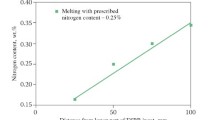A new armor lining steel 100Kh3G2MTR is fabricated and investigated. Different regimes of heat treatment of the steel are studied for the purpose of achieving optimal characteristics of abrasive and shock-abrasive resistance in combination with enhanced surface hardness with satisfactory strength and impact toughness of the metallic matrix. Astructural analysis is performed and the mechanism of phase transformations in the surface layer in the course of heat treatment and in service is described.









Similar content being viewed by others
References
S. E. Svoikina (Krylova), V. A. Moskalenko, and V. I. Gryzunov, “Development of an optimal alloy that assures long-term, failure-free operation of equipment under conditions of impact-abrasive wear,” Stal’, No. 3, 201 – 210 (2005).
S. E. Krylova, V. I. Gryzunov, and V. A. Lysov, “Application of method of prioritizing for synthesis of alloys exhibiting optimal wear resistance,” in: Proc. Intern. Sci. Conf. “Innovative Activity of Enterprises in the Investigation, Development, and Fabrication of Modern Construction Materials and Alloys [in Russian], Mashinostroenie, Moscow (2009) (2009) , pp. 370 – 380.
S. E. Krylova, “Influence of heat treatment on evolution of the structure of sparingly alloyed instrument-class steels,” in: Proc. Intern. Sci. Conf. “Innovative Activity of Enterprises in the Investigation, Development, and Fabrication of Modern Construction Materials and Alloys” [in Russian], Mashinostroenie, Moscow (2009), pp. 410 – 420.
L. I. Mirkin, X-ray Diffraction Analysis [in Russian], Nauka, Moscow (1976), 378 p.
S. S. Gorelik and Yu. A. Skakov, X-ray Graphical and Electrooptical Analysis. Textbook for Post-secondary Educational Institutions [in Russian], Moscow Institute of Steel and Alloys, Moscow (1994), 328 p.
S. E. Krylova (Svoikina), Ye. V. Bratkovskii, and O. V. Samokhina, “On the search for an advanced technology for the development of impact-abrasive steels,” in: Jubilee Collection of Scientific Studies of the Department of Materials Science and Metals Technology [in Russian], Izd-vo OGTI, Orsk (2004), pp. 129 – 138.
G. M. Sorokin, V. N. Vinogradov, and V. A. Dotsenko, Abrasive Wear of Drilling Equipment [in Russian], Nedra, Moscow (1980), 207 p.
G. M. Sorokin, Tribology of Steels and Alloys [in Russain], Nedra, Moscow (2000), 368 p.
Author information
Authors and Affiliations
Additional information
Translated from Metallovedenie i Termicheskaya Obrabotka Metallov, No. 5, pp. 38 – 46, May, 2011.
Rights and permissions
About this article
Cite this article
Krylova, S.E., Gryzunov, V.I., Firsova, N.V. et al. Conditions of structure formation in sparingly alloyed steels intended for service under enhanced wear. Met Sci Heat Treat 53, 239–247 (2011). https://doi.org/10.1007/s11041-011-9376-0
Published:
Issue Date:
DOI: https://doi.org/10.1007/s11041-011-9376-0




